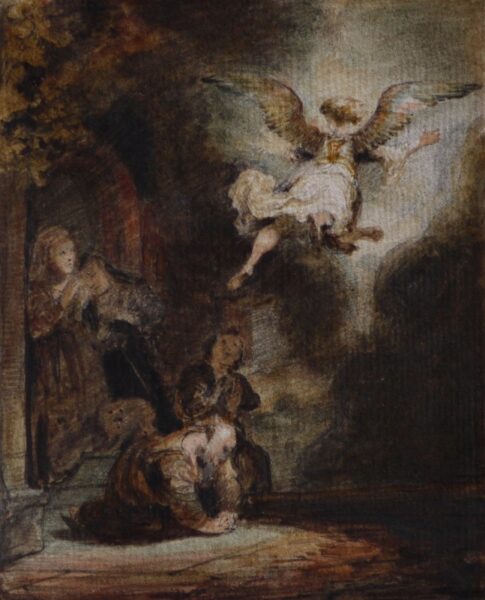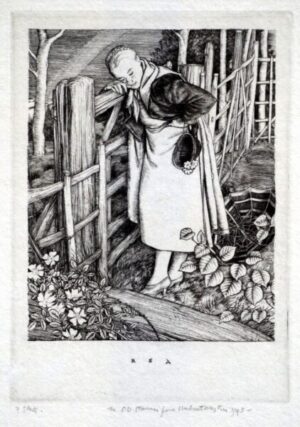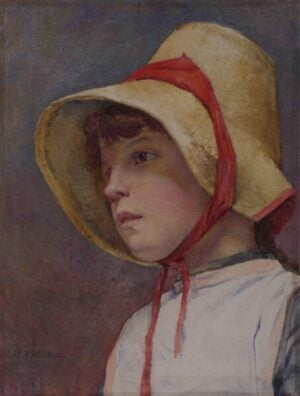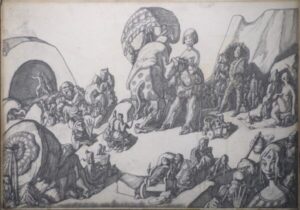Wilkie, Sir David (1785-1841)
Wilkie was the son of a parish minister, the Rev David Wilkie, and his wife Isabella Lister. He was born in the old manse of Cults Kirk south-west of Cupar in Fife. He showed considerable artistic talent from an early age and in 1799 his father agreed, reluctantly, to his studying to become a painter. With the help of the influential local laird, the Earl of Leven, Wilkie gained admission to the Trustees' Academy in Edinburgh, where he studied under John Graham. He gained an early reputation for his ability to draw characters. He became well known for visiting markets and fairs, sketching people and scenes that caught his attention. He also became an enthusiastic admirer of David Allan's watercolours of everyday life. While at the Trustees' Academy, Wilkie produced several paintings recognised as being of outstanding quality given his experience, and in 1803 he won a ten guinea prize for a painting of the classical subject Diana and Calisto.
Wilkie returned to the family home in Fife in 1804 and began work on his first major painting, of Pitlessie Fair, which portrayed some 140 characters including neighbours and relatives. He sold Pitlessie Fair for £25 in 1805, and together with the income he had made from portrait commission, this allowed him to move to London to attend the Royal Academy. More portrait commissions followed, and two of his early larger works, Village Politicians and The Blind Fiddler attracted considerable interest. He became known as "the Scottish Teniers" after the Flemish painter he had come to admire since arriving in London. Other notable pictures from this period included The Card-Players and Rent Day.
In 1809 Wilkie was elected as an Associate of the Royal Academy, and two years later he became a full member of the Royal Academy. By now Wilkie was counted amongst the greatest artists of his day. His next major work was originally called the Ale House Door, though later renamed The Village Festival. This now hangs in the National Gallery but was first sold by Wilkie for 800 guineas. In 1813 he painted Blind Man's Buff, a commission from the Prince Regent, who also paid for a companion picture, The Penny Wedding, in 1818. Wilkie's paintings were proving such a huge hit with the public that when The Chelsea Pensioners was shown at the Royal Academy in 1822, barriers had to be erected to control the crowds who flocked to see it.
In 1822 Wilkie was in Edinburgh to record the visit by King George IV, the first visit to Scotland by a reigning monarch since 1650. The following year he was appointed Royal Limner for Scotland on the death of Sir Henry Raeburn, and had several sitting with King George in preparation for the portrait he would produce to mark the 1822 visit to Edinburgh. The painting proved an exceptionally difficult one for Wilkie. Perhaps it was simply the problem of reconciling his integrity as an artist with a desire not to leave his very important subject feeling insulted by the end result. The strain led Wilkie to decide to go abroad, and between 1825 and 1828 he travelled through France, Italy and Spain. He completed his royal portrait after returning to England in 1828, under the title Reception of the King at the Entrance of Holyrood Palace. In the end, diplomacy overcame artistic rigour. The rotund King was slimmed down in Wilkie's portrait; his livid scarlet tartan outfit was shown in subdued lighting; and the pink tights the King had worn under his kilt to cover his legs were not shown at all.
Wilkie's three years on the continent, and especially his time in Spain, had transformed his style into something much more free-flowing. This was not well received by much of his popular following and by many critics. But George IV remained an admirer, and in 1830 he appointed Wilkie to the honorary post of "Painter in Ordinary to the King". And in 1836, Wilkie received a Knighthood.
In 1840 Sir David Wilkie embarked on a major tour of the Middle East. Travelling out via Holland and Germany, he spent four months in Turkey, before moving on the Holy Land, and then to Egypt. On his way back to Britain, he was taken ill on board his ship off Malta and died in the western Mediterranean on the morning of the 1 June 1841. He was buried at sea in the Bay of Gibraltar. Wilkie's last painting was a portrait of Muhammad Ali Pasha, Viceroy of Egypt, produced while he was staying in Alexandria. There is a memorial to him in Cults Kirk.



